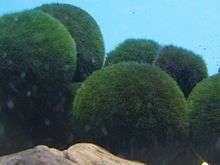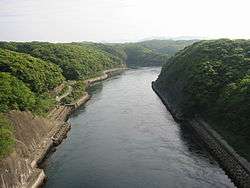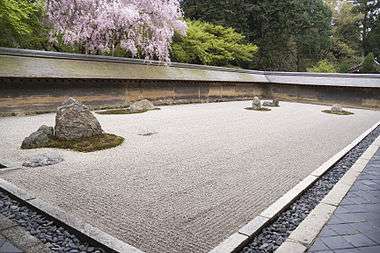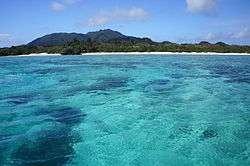Monuments of Japan

Monuments (記念物 kinenbutsu) is a collective term used by the Japanese government's Law for the Protection of Cultural Properties to denote Cultural Properties of Japan[note 1] as historic locations such as shell mounds, ancient tombs, sites of palaces, sites of forts or castles, monumental dwelling houses and other sites of high historical or scientific value; gardens, bridges, gorges, mountains, and other places of great scenic beauty; and natural features such as animals, plants, and geological or mineral formations of high scientific value.[1]
Designated Monuments of Japan
The government designates (as opposed to registers: see Registered Monuments below) "significant" items of this kind as Cultural Properties and classifies them in one of three categories:
- Historic Sites (史跡 shiseki)
- Places of Scenic Beauty (名勝 meishō),
- Natural Monuments (天然記念物 tennen kinenbutsu).
Items of particularly high significance may receive a higher classification as:
- Special Historic Sites (特別史跡 tokubetsu shiseki)
- Special Places of Scenic Beauty (特別名勝 tokubetsu meishō)
- Special Natural Monuments (特別天然記念物 tokubetsu tennen kinenbutsu) respectively.[2]
As of September 2013, there were 3,089 nationally designated Monuments: 1,710 Historic Sites (including 61 Special Historic Sites), 374 Places of Scenic Beauty (including 36 Special Places of Scenic Beauty), and 1,005 Natural Monuments (including 75 Special Natural Monuments).[3] Since a single property can be included within more than one of these classes, the total number of properties is less than the sum of designations: for example Hamarikyu Gardens are both a Special Historic Site and a Special Place of Scenic Beauty.[2]
As of 1 May 2013, there were a further 2,961 Historic Sites, 266 Places of Scenic Beauty, and 2,985 Natural Monuments designated at a prefectural level and 12,840 Historic Sites, 845 Places of Scenic Beauty, and 11,020 Natural Monuments designated at a municipal level.[4][5]
Alterations to the existing state of a site or activities affecting its preservation require permission from the Commissioner for Cultural Affairs. Financial support for purchasing and conserving designated land and for the utilization of the site is available through local governments.[2]
Designation criteria
The Agency for Cultural Affairs designates monuments based on a number of criteria. A monument can be designated based on more than one of these criteria.[6]
Historic Sites and Special Historic Sites
- Shell mounds, settlement ruins, kofun, other historic ruins of this type
- Ruins of fortified towns, castles, government administration offices, old battlefields and other historic ruins related to politics or government (都城跡、国郡庁跡、城跡、官公庁、戦跡その他政治に関する遺跡)
- Remains of shrines and temples, former compound grounds and other historic ruins related to religion (社寺の跡又は旧境内その他祭祀信仰に関する遺跡)
- Schools, research institutions, cultural facilities and other historic ruins related to education, learning or culture (学校、研究施設、文化施設その他教育・学術・文化に関する遺跡)
- Medical care and welfare facilities, life related institution, other society and life related historic ruins (医療・福祉施設、生活関連施設その他社会・生活に関する遺跡)
- Transport and communication facilities, forest conservation and flood control facilities, manufacture facilities and other historic sites related to finance or manufacture activities (交通・通信施設、治山・治水施設、生産施設その他経済・生産活動に関する遺跡)
- Graves and stone monuments with inscriptions (墳墓及び碑)
- Former residences, gardens, ponds and other areas of particular historical significance (旧宅、園池その他特に由緒のある地域の類)
- Ruins related to foreign countries or foreigners (外国及び外国人に関する遺跡)
Places of Scenic Beauty and Special Places of Scenic Beauty
- Parks and gardens (公園、庭園)
- Bridges and embankments (橋梁、築堤)
- Flowering trees, flowering grass, autumn colors, green trees and other places of dense growth (花樹、花草、紅葉、緑樹などの叢生する場所)
- Places inhabited by birds and wild animals, fish/insects and others (鳥獣、魚虫などの棲息する場所)
- Rocks, caves (岩石、洞穴)
- Ravines, gorges, waterfalls, mountain streams, abysses (峡谷、瀑布、溪流、深淵)
- Lakes, marshes, wetlands, floating islands, springs (湖沼、湿原、浮島、湧泉)
- Sand dunes, spits, seasides, islands (砂丘、砂嘴、海浜、島嶼)
- Volcanoes, onsen (火山、温泉)
- Mountains, hills, plateaus, plains, rivers (山岳、丘陵、高原、平原、河川)
- Viewpoints (展望地点)
Natural Monuments and Special Natural Monuments
- Animals (動物)
- Well-known animals peculiar to Japan and their habitat (日本特有の動物で著名なもの及びその棲息地)
- Animals which are not peculiar to Japan, but need to be preserved as well-known characteristic Japanese animals, and their habitat (特有の産ではないが、日本著名の動物としてその保存を必要とするもの及びその棲息地)
- Animals or animal groups peculiar to Japan within their natural environment (自然環境における特有の動物又は動物群聚)
- Domestic animals peculiar to Japan (日本に特有な畜養動物)
- Well-known imported animals presently in a wild state, with the exception of domestic animals; their habitat (家畜以外の動物で海外よりわが国に移殖され現時野生の状態にある著名なもの及びその棲息地)
- Particularly valuable animal specimen (特に貴重な動物の標本)
- Plants, vegetation (植物)
- Old trees of historic interest, gigantic trees, old trees, deformed trees, cultivated pulpwood, roadside trees, shrine forests (名木、巨樹、老樹、畸形木、栽培植物の原木、並木、社叢)
- Representative primeval forests, rare forest flora (代表的原始林、稀有の森林植物相)
- Representative alpine plants, special clusters of plants on rock ground (代表的高山植物帯、特殊岩石地植物群落)
- Representative clusters of waste land plants (代表的な原野植物群落)
- Representative examples of coastal and sand ground vegetation (海岸及び沙地植物群落の代表的なもの)
- Representative examples of areas of peat forming plants (泥炭形成植物の発生する地域の代表的なもの)
- Clusters of plants growing in caves or grottoes (洞穴に自生する植物群落)
- Rare water plants in garden ponds, onsen, lakes, marshes, streams, sea, etc.; algae, moss, microbes, etc. (池泉、温泉、湖沼、河、海等の珍奇な水草類、藻類、蘚苔類、微生物等の生ずる地域)
- Remarkable occurrence of epiphytic plants on rocks, trees or shrubs (着生草木の著しく発生する岩石又は樹木)
- Remarkable plant growth on marginal land (著しい植物分布の限界地)
- Remarkable growth in the wild of crop plants (著しい栽培植物の自生地)
- Wild habitat of rare or near extinct plants (珍奇又は絶滅に瀕した植物の自生地)
- Geological and mineralogical features (地質鉱物)
- Rocks, mineral and fossil producing sites (岩石、鉱物及び化石の産出状態)
- Conformable and unconformable strata (地層の整合及び不整合)
- Fold and thrust strata (地層の褶曲及び衝上)
- Geological features caused by the work of living creatures (生物の働きによる地質現象)
- Phenomena related to earthquake dislocation and landmass motion (地震断層など地塊運動に関する現象)
- Caves, grottoes (洞穴)
- Examples of rock organization (岩石の組織)
- Onsen and their sediments (温泉並びにその沈澱物)
- Erosion and weathering related phenomena (風化及び侵蝕に関する現象)
- Fumaroles and other items related to volcanic activity (硫気孔及び火山活動によるもの)
- Ice and frost related phenomena (氷雪霜の営力による現象)
- Particularly precious rock, mineral and fossil specimen (特に貴重な岩石、鉱物及び化石の標本)
- Representative territories rich in natural monuments to be protected (Natural Protected Areas) (保護すべき天然記念物に富んだ代表的一定の区域(天然保護区域))
Registered Monuments
A separate system of registration has been established for modern edifices threatened by urban sprawl or other factors. Monuments from the Meiji period onward which require preservation can be registered as Registered Monuments (登録記念物).[2] Members of this class of Cultural Property receive more limited assistance and protection based mostly on governmental notification and guidance. As of April 2012, 61 monuments were registered under this system.[7]
Some Monuments of Japan
 Kenroku-en, Kanazawa, Ishikawa is a Special Place of Scenic Beauty
Kenroku-en, Kanazawa, Ishikawa is a Special Place of Scenic Beauty Saihō-ji's moss garden is both a Special Place of Scenic Beauty and a Historic Site
Saihō-ji's moss garden is both a Special Place of Scenic Beauty and a Historic Site
 The Sannai-Maruyama site is a Special Historic Site
The Sannai-Maruyama site is a Special Historic Site
See also
- List of Special Places of Scenic Beauty, Special Historic Sites and Special Natural Monuments
- Cultural Properties of Japan
- Meibutsu
Notes
- ↑ In this article, capitals indicate an official designation as opposed to a simple definition, e.g "Cultural Properties" as opposed to "cultural properties".
References
- ↑ "Cultural Properties for Future Generations" (PDF). Administration of Cultural Affairs in Japan. Agency for Cultural Affairs. March 2013. Retrieved 21 September 2013.
- 1 2 3 4 "Preservation and Utilization of Cultural Properties" (PDF). Administration of Cultural Affairs in Japan. Agency for Cultural Affairs. 2012. Retrieved 21 September 2012.
- ↑ 史跡名勝天然記念物 [Count of Monuments of Japan by Prefecture] (in Japanese). Agency for Cultural Affairs. 1 September 2013. Retrieved 21 September 2013.
- ↑ 都道府県別指定等文化財件数(都道府県分) [Count of Prefectural Cultural Properties by Prefecture] (in Japanese). Agency for Cultural Affairs. Retrieved 21 September 2013.
- ↑ 都道府県別指定等文化財件数(市町村分) [Count of Municipal Cultural Properties by Prefecture] (in Japanese). Agency for Cultural Affairs. Retrieved 21 September 2013.
- ↑ 昭和二十六年文化財保護委員会告示第二号(国宝及び重要文化財指定基準並びに特別史跡名勝天然記念物及び史跡名勝天然記念物指定基準) [Bulletin of the Association for the rehabilitation of cultural properties, number 2 from 1951 (Designation criteria for National Treasures, Important Cultural Properties, Special Historic Sites, Places of Scenic Beauty, Natural Monuments)] (in Japanese). Tokyo: MEXT. Retrieved 2010-01-01.
- ↑ 登録文化財 [Registered Cultural Properties] (PDF) (in Japanese). Agency for Cultural Affairs. Retrieved 20 April 2012.
External links
| Wikimedia Commons has media related to Agency for Cultural Affairs—Cultural Properties. |





